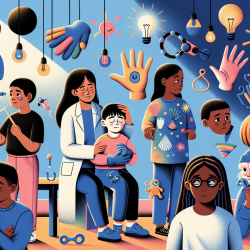Introduction
In the ever-evolving field of speech-language pathology, the integration of innovative tools and data-driven methodologies is crucial for achieving optimal outcomes. One such tool that has recently emerged is the Multilingual Picture Database, a comprehensive resource that provides naming norms and familiarity scores for 500 colored pictures across 32 languages. This database, as detailed in the research article "The Multilingual Picture Database," offers a groundbreaking opportunity for practitioners to enhance their therapeutic strategies, particularly in multilingual settings.
The Significance of Multilingual Picture Databases
Multilingualism is increasingly becoming the norm, with more than half of the world's population speaking two or more languages. This linguistic diversity presents unique challenges and opportunities in language therapy. Traditional picture databases have been limited in scope, often focusing on a single language or a small set of languages. The Multilingual Picture Database overcomes these limitations by providing a standardized set of images that have been normed across a wide array of languages.
By utilizing this database, practitioners can:
- Enhance cross-linguistic research by accessing consistent naming norms and familiarity scores.
- Design more effective and culturally relevant therapy sessions.
- Improve diagnostic accuracy by using validated tools across multiple languages.
Implementing the Database in Practice
For speech-language pathologists, the practical application of the Multilingual Picture Database can lead to significant improvements in therapy outcomes. Here are some ways practitioners can implement this tool:
- Assessment: Use the database to assess naming and familiarity in different languages, providing a more comprehensive understanding of a child's linguistic capabilities.
- Therapy Design: Develop targeted therapy plans that incorporate culturally relevant images, enhancing engagement and effectiveness.
- Research and Development: Encourage further research into multilingualism and its impact on language development, using the database as a foundational tool.
Encouraging Further Research
The Multilingual Picture Database is not just a tool for immediate application but also a catalyst for further research. By providing a standardized set of images across multiple languages, it opens the door for new studies on language acquisition, processing, and disorders in multilingual contexts. Researchers are encouraged to explore these areas, contributing to a deeper understanding of multilingualism and its implications for speech-language pathology.
Conclusion
The Multilingual Picture Database represents a significant advancement in the resources available to speech-language pathologists. By integrating this tool into practice, practitioners can make data-driven decisions that enhance therapy outcomes for children, particularly in multilingual environments. As we continue to embrace linguistic diversity, tools like the Multilingual Picture Database will be invaluable in shaping the future of language therapy.
To read the original research paper, please follow this link: The Multilingual Picture Database.










